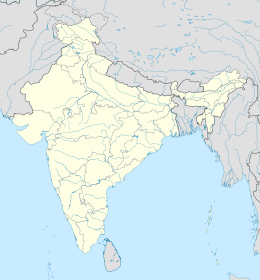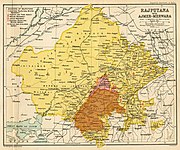Conquest of Mandalgarh
This article may require copy editing for grammar, style, cohesion, tone, or spelling. (April 2024) |
| Conquest of Mandalgarh | |||||||||
|---|---|---|---|---|---|---|---|---|---|
| Part of Mewar-Malwa Conflict | |||||||||
 | |||||||||
| |||||||||
| Belligerents | |||||||||
| Malwa Sultanate |
| ||||||||
| Commanders and leaders | |||||||||
| Mahmud Khalji |
| ||||||||
Location within Rajasthan | |||||||||
The Conquest of Mandalgarh was a military expedition led by Sultan Mahmud Khalji of Malwa against Mewar. The primary objective of this campaign was to capture the Mandalgarh fort, which was under the command of Uparamal, a subordinate of Rana Kumbha. Mahmud Khalji marched towards Mewar in the year 1457 to achieve this goal.
This time, he personally surveyed all the hillocks surrounding the fort and selected the western hillock as the base for his operations.
The Mandalgarh fort, located in the city of Mandalgarh, is situated in the Bhilwara District of Rajasthan, India. During the year 1457, this territory was under the control of Rana Kumbha.[4] Mahmud was able to capture the fort after a few days of siege. The Hadas of Bundi, who had Mandalgarh taken from them by Rana Kumbha and had accepted the suzerainty of Mahmud Khalji of Malwa, harbored strong animosity towards the Rana. The conflict over the succession in Nagaur between Shams Khan, son of Firuz Khan, and Mujahid Khan, brother of Firuz Khan, drew Rana Kumbha into the dispute.[5] The Rana was not present in the conflict as he was busy fighting the Sultan of Gujarat, reinforcements were also not sent due to this reason. The fort was recaptured by Kumbha within a few days.[6]
Background[edit]
-
Mandalgarh Fort
-
Map of Mewar Including Mandalgarh
Upon reaching the proximity of the Mewar territory, Sultan Mahmud Khalji's armies were joined by forces from other regions of his kingdom. It appears that Mahmud Khalji marched through the lands belonging to Mewar, issuing orders to his army to destroy anything in their path, including cultivated fields and temples. These orders were given as a means of showcasing the ruler's inability to protect the lives, property, and religion of those affected by his campaigns. Having acquired knowledge from previous assaults, Mahmud Khalji was aware of the formidable nature of the fort, situated atop a hill amidst rugged terrain and dense vegetation.
Setting up his camp at a distance from the fort, Mahmud Khalji personally surveyed the area, identifying a high hill on the western side that provided a strategic advantage for a potential attack. Despite the challenges posed by the rough terrain and dense jungle covering the hill, Mahmud Khalji initiated the clearance of foliage and excavation of rocks to create a passage to the hilltop. Skirmishes occurred during the road preparation, prompting Mahmud Khalji to deploy soldiers to engage the Rajputs while ensuring the passage construction remained undisturbed.
After successfully establishing his camp at the hilltop, Mahmud Khalji commenced the siege by encircling the fort from all directions, blocking off any potential entry points. Manjaniks and Maghribis were strategically positioned to facilitate the assault, with the utilization of a manjanik-i-rakabi for targeting and damaging the fortification walls. The Rajputs within the fort also employed manjaniks to repel the attackers and inflict heavy casualties on those near the walls.[4][7][8]
The conquest[edit]
In 1456-57, Sultan Mahmud Khalji once again besieged the fort of Mandalgarh. Although he was able to capture the lower fort, the hill fort proved to be more difficult to conquer.
After the capture of Mandalgarh, Sultan Mahmud Khalji destroyed all the temples in the area and had mosques built in their place. He appointed mullas to perform the daily worship in these mosques. He then returned to Mandu via Chittor, sending his sons on missions to ravage the country of the Bhils and Kolis as well as seizing the fort of Bundi after a fierce battle with its Rajput defenders.
As the siege persisted, an unexpected turn of events occurred when stones hurled by the Manjanik from outside inadvertently damaged the most effective Manjaniks within the fort of Mandalgarh, rendering them unfit for use. This development brought great satisfaction to the besiegers, yet the defending forces remained resolute in their efforts to protect the fort. Any damage inflicted on the walls by the attackers was promptly repaired, thanks to the fort's sturdy construction. However, the relentless assault with matin and zopin eventually resulted in a significant breach in the outer fortifications, causing chaos among the fort's occupants as they sought refuge within the inner fort of Mandalgarh.
Recognizing the strategic importance of a water reservoir within the fort, which provided a crucial advantage to the defenders, Sultan Mahmud Khalji ordered an attack on the reservoir's dams. The breach caused the water to escape and become contaminated, creating a water shortage that added to the besieged's hardships and increased the likelihood of a swift surrender. Additionally, Mahmud Khalji instructed the filling of a portion of the ditch surrounding the outer wall to facilitate access for his army and enable entry into the fort.
Once the ditch was filled, the defenders emerged from the inner fort with determination, engaging in a fierce battle. While some Rajputs valiantly fought to the end, others opted to surrender, offering ten lacs of tankas as tribute and relinquishing control of the fort.However, due to the failing reservoirs of water caused by the firing of the cannons, the garrison eventually surrendered. Ultimately, the fort was successfully captured on 20th October 1457.[4][8][7][9]
Aftermath[edit]
After allowing the occupants of the Mandalgarh fort to evacuate without further hindrance and releasing the captives upon payment of the required tribute, Sultan Mahmud Khalji proceeded to enter the Mandalgarh fort on the 6th of Zilhijja. Inside the fort, he demolished the old temple and utilized its materials to construct a mosque in its place. Furthermore, he appointed a qazi, a mufti, a muhtasib, a khatib, and a muazzin, establishing their stipends as well. These actions signified a symbolic transition to a permanent occupation, demonstrating the transformation that had occurred rather than being driven solely by religious fervor. With his long-held ambitions fulfilled and arrangements in place, Sultan Mahmud Khalji then shifted his focus to other endeavors.[10][11] The fort was later recaptured by Rana Kumbha.[6]
See also[edit]
References[edit]
- ^ Rizvi, Saiyid Athar Abbas (1987). The Wonder that was India: A Survey of the History and Culture of the Indian Sub-continent from the Coming of the Muslims to the British Conquest, 1200-1700. Sidgwick & Jackson. p. 67. ISBN 978-0-283-99458-6.
- ^ Singh, Rajvi Amar (1992). Mediaeval History of Rajasthan: Western Rajasthan. Rajvi Amar Singh. p. 181.
- ^ Palat, Ravi (2015). The Making of an Indian Ocean World-Economy, 1250-1650. Palgrave Macmillan. ISBN 9781137562265.
- ^ a b c Day, Upendra Nath (1965). Medieval Malwa: A Political and Cultural History, 1401-1562. Munshi Ram Manohar Lal. pp. 187–190. ISBN 978-81-215-0401-0.
- ^ Day, Upendra Nath (1965). Medieval Malwa: A Political and Cultural History, 1401-1562. Munshi Ram Manohar Lal. p. 191. ISBN 978-81-215-0401-0.
- ^ a b Somani, Ram Vallabh9 (1976). History of Mewar: from earliest times to 1751 A.D. C.L. Ranka, Jaipur. pp. Page no. 136 - 137.
{{cite book}}: CS1 maint: numeric names: authors list (link) - ^ a b A Comprehensive History of India: The Delhi Sultanat, A.D. 1206-1526, edited by Mohammad Habib and Khaliq Ahmad Nizami. People's Publishing House. 1970. p. 917.
- ^ a b Somānī, Rāmavallabha (1976). History of Mewar, from Earliest Times to 1751 A.D. Mateshwari Publications. pp. 136–137.
- ^ Hooja, Rima (2006). A History of Rajasthan. Rupa & Company. p. 342. ISBN 978-81-291-0890-6.
- ^ Ratnawat, Shyam Singh; Sharma, Krishna Gopal (1999). History and Culture of Rajasthan: From Earliest Times Upto 1956 A.D. Centre for Rajasthan Studies, University of Rajasthan. p. 145.
- ^ Jain, Kailash Chand (2010). History of Jainism: Historical survey and spread of Jainism. D.K. Printworld. p. 555. ISBN 978-81-246-0549-3.





